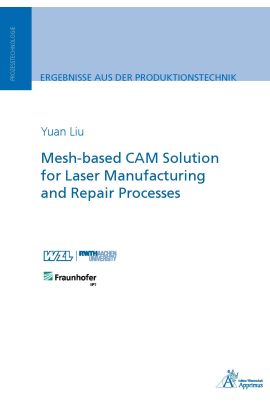The research of this thesis aims at a computer-aided solution for the generation of precise laser paths on part surfaces for repair processes based on material deposition. Since parts in the turbine industry such as single blades and blisk blades are easily subject to shape deviations and surface defects arising from wear in use and error from manufacturing, laser-scanning process is employed to acquire accurate geometry information of each individual part. However, laser scanning can only deliver discrete data of geometries, such as triangulated meshes, which lack continuous and analytic geometric information and features. To overcome the difficulty of identifying boundary geometry features in discrete geometric data, a series of feature recognition and identification methods are studied, compared with each other and optimal approaches are proposed based on test and comparison to automatically extract geometric features of repair areas. Necessary data processing techniques are also discussed and used to improve the data quality of the identified geometric features, which are used as the input of computer-aided manufacturing (CAM) planning.
A special pattern of laser movement with equal distance between each two neighboring laser paths on the part surface is required from the laser repair process. Solution of discrete geodesic problems is the basis to generate laser paths with such a repair strategy on triangulated faces contained in the measured data. Firstly, a discrete geodesic method proposed by Mitchell, Mount and Papadimitriou (MMP) is studied to solve the problem of calculating distance between any two points on polyhedral surface. Improvement of some techniques and data structure in this classic method are proposed. Furthermore, an extension of this method to generate polylines with exact equidistance between each other on triangulated faces is researched. This exact algorithm is compared with previous work and the advantages are shown. To simplify the problem and also increase the computation speed, an approximate algorithm inherited from Sethian’s fast marching method (FMM) is researched afterwards. A geodesic distance field based on vertex is constructed, and a front propagation procedure is executed to divide the part surface in stripes with equal width. The error of this approximate algorithm and analysis of computation complexity are discussed. Some results both in freeform test geometries and on real repair areas on turbine blades are demonstrated in the thesis.
| Autor | Liu, Yuan |
|---|---|
| Lieferzeit | 3-4 Tage |
| Gewicht | 0.23 kg |
| Erscheinungsdatum | 11.04.2017 |
Prozesstechnologie
Mesh-based CAM Solution for Laser Manufacturing and Repair Processes
Kurzbeschreibung
The thesis studied a systematic and automatic solution of generating precise laser paths only based on measured data for repair processes of turbine components. The solution has significantly shortened the processing time, enhanced the automaticity and increased the precision for several industrial repair cases. The methods researched in the thesis, such as numerical computation, geometric calculation and data processing, can be extended to other manufacturing applications and industry automation.

